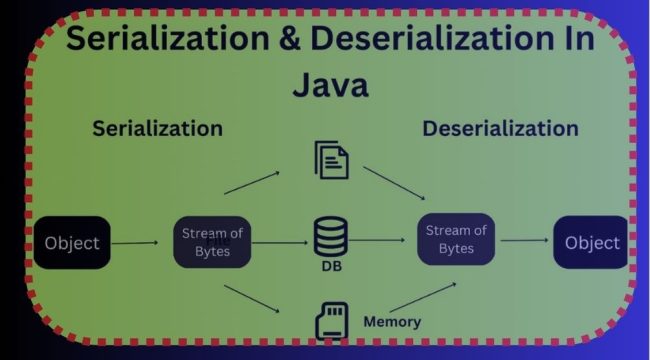Top Java Serialization Interview Questions and Answers for 2025
Serialization and Deserialization are key concepts in Java, often asked in interviews. Serialization converts Java objects into a byte stream, while Deserialization reverses this process.
These techniques are used for saving or transferring object data. Developers must understand how they work to answer common interview questions like “What is serialization in Java?” or “Why is serialization used?” Being prepared for these questions can help you stand out in interviews and showcase your Java expertise. This article covers important serialization concepts and real-world examples.

1. What is Serialization in Java? Imp question for fresher & experience
Serialization in Java is the process of converting Java objects into a byte stream. This byte stream can be transferred over a network, saved to a file, or stored in a database for future use. Serialization allows us to save the state of an object so that it can be recreated later.
2. What is Deserialization in Java? Imp question for fresher & experience
Deserialization is the reverse process of Serialization. It is when the byte stream (that was transferred or saved) is converted back into a Java object. This process is needed when the byte stream arrives on the other side of the network or when the saved object needs to be used again.
Example of Serialization and Deserialization in Java
import java.io.*; class Car implements Serializable { String name = "Tesla"; String owner = "Elon Musk"; int year = 1958; // If you use the transient keyword, this variable won't be serialized }//Serialization
public class SerializationDeserializationExample { public static void main(String[] args) { // Serialization - Saving object to file try { Car myCar = new Car(); String filename = "serializable.ser"; FileOutputStream fos = new FileOutputStream(filename); ObjectOutputStream oos = new ObjectOutputStream(fos); oos.writeObject(myCar); oos.flush(); oos.close(); System.out.println("Serialization success"); } catch (Exception e) { System.out.println(e); }// Deserialization - Reading object from file try { FileInputStream fis = new FileInputStream("serializable.ser"); ObjectInputStream ois = new ObjectInputStream(fis); Car readCar = (Car) ois.readObject(); System.out.println("\nDeserialized data below:"); System.out.println("Car name: " + readCar.name); System.out.println("Car owner: " + readCar.owner); System.out.println("Car production year: " + readCar.year); ois.close(); } catch (Exception e) { System.out.println(e); } } }
3. Why Do We Need Serialization in Java? Imp question for fresher & experience
Serialization is essential for several reasons:
- Data Transmission: Allows data to be transferred between systems. Transfer the data over a network between 2 or multiple system.
- Persistence: Enables storing object data in files or databases for future retrieval.
- Deep Cloning: Helps in creating a deep copy of an object.
- Cross-JVM Communication: Useful for sending objects between different Java Virtual Machines.
- Stashing: Can save the state of an object to be resumed later.
4. How to Make a Class Serializable in Java? Imp question for fresher
To make a class serializable in Java, you need to implement the Serializable interface. This marks the class as capable of being serialized. Optionally, you can also implement the Externalizable interface for more control over the serialization process.
5. What is a Marker Interface? Most Imp question for fresher & experience
A Marker Interface is an interface that does not contain any methods or fields. It simply marks a class as having a certain property or behavior. The Serializable interface is an example of a marker interface. The JVM checks if a class implements the Serializable interface to determine if it can be serialized.
Example: Custom Marker Interface
Here’s how you can create a simple Marker Interface and use it in a class:
// Marker Interface
interface MyMarkerInterface {
// No methods or fields in this interface
}
// Class that implements the Marker Interface
class MyClass implements MyMarkerInterface {
String name;
MyClass(String name) {
this.name = name;
}
public void display() {
System.out.println("Class Name: " + name);
}
}
public class MarkerInterfaceExample {
public static void main(String[] args) {
MyClass obj = new MyClass("Marker Interface Example");
// Check if the object is an instance of MyMarkerInterface
if (obj instanceof MyMarkerInterface) {
System.out.println("This class is marked with MyMarkerInterface");
obj.display();
} else {
System.out.println("This class is not marked with MyMarkerInterface");
}
}
}
Explanation:
- MyMarkerInterface: This is an interface that doesn’t define any methods. It simply serves to mark classes that implement it.
- MyClass: This class implements
MyMarkerInterfacebut doesn’t have to define any methods from the interface since it’s just a marker. - Instance Check: In the
mainmethod, we use theinstanceofoperator to check if the object is an instance ofMyMarkerInterface. If true, it indicates thatMyClassis marked with the marker interface.
Output:
This class is marked with MyMarkerInterface
Class Name: Marker Interface Example
Marker interfaces like Serializable, Cloneable, or MyMarkerInterface are useful to signal to the JVM or other parts of the program that an object has a particular property or behavior. In this example, the MyMarkerInterface doesn’t add any new behavior, but it marks the MyClass as having a special characteristic that can be used in logic like object validation or customized processing.
Examples of Marker Interfaces:
SerializableCloneable
6. Why is the Serializable Interface Called a Marker Interface?
The Serializable interface is called a Marker Interface because it does not contain any methods or fields. It simply marks a class as serializable, indicating to the Java runtime that the class can be serialized.
7. What is serialVersionUID?
serialVersionUID is a unique identifier for serializable classes. It is a static final variable that helps in version control during serialization. If a class is changed (e.g., fields are added or removed), the serialVersionUID helps to ensure that the correct version of the class is used during deserialization. If the serial version does not match, an exception is thrown.
8. How to Restrict Variables from Being Serialized?
To exclude certain variables from being serialized, you can mark them with the transient keyword. This tells Java not to serialize those variables.
transient int year; // This variable will not be serialized
By using transient, you can control which data should not be saved during the serialization process.
